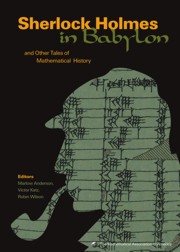Book contents
- Frontmatter
- Introduction
- Contents
- Ancient Mathematics
- Medieval and Renaissance Mathematics
- The Seventeenth Century
- Foreword
- An Application of Geography to Mathematics: History of the Integral of the Secant
- Some Historical Notes on the Cycloid
- Descartes and Problem-Solving
- René Descartes' Curve-Drawing Devices: Experiments in the Relations Between Mechanical Motion and Symbolic Language
- Certain Mathematical Achievements of James Gregory
- The Changing Concept of Change: The Derivative from Fermat to Weierstrass
- The Crooked Made Straight: Roberval and Newton on Tangents
- On the Discovery of the Logarithmic Series and Its Development in England up to Cotes
- Isaac Newton: Man, Myth, and Mathematics
- Reading the Master: Newton and the Birth of Celestial Mechanics
- Newton as an Originator of Polar Coordinates
- Newton's Method for Resolving Affected Equations
- A Contribution of Leibniz to the History of Complex Numbers
- Functions of a Curve: Leibniz's Original Notion of Functions and Its Meaning for the Parabola
- Afterword
- The Eighteenth Century
- Index
- About the Editors
The Changing Concept of Change: The Derivative from Fermat to Weierstrass
from The Seventeenth Century
- Frontmatter
- Introduction
- Contents
- Ancient Mathematics
- Medieval and Renaissance Mathematics
- The Seventeenth Century
- Foreword
- An Application of Geography to Mathematics: History of the Integral of the Secant
- Some Historical Notes on the Cycloid
- Descartes and Problem-Solving
- René Descartes' Curve-Drawing Devices: Experiments in the Relations Between Mechanical Motion and Symbolic Language
- Certain Mathematical Achievements of James Gregory
- The Changing Concept of Change: The Derivative from Fermat to Weierstrass
- The Crooked Made Straight: Roberval and Newton on Tangents
- On the Discovery of the Logarithmic Series and Its Development in England up to Cotes
- Isaac Newton: Man, Myth, and Mathematics
- Reading the Master: Newton and the Birth of Celestial Mechanics
- Newton as an Originator of Polar Coordinates
- Newton's Method for Resolving Affected Equations
- A Contribution of Leibniz to the History of Complex Numbers
- Functions of a Curve: Leibniz's Original Notion of Functions and Its Meaning for the Parabola
- Afterword
- The Eighteenth Century
- Index
- About the Editors
Summary
Some years ago while teaching the history of mathematics, I asked my students to read a discussion of maxima and minima by the seventeenth-century mathematician, Pierre Fermat. To start the discussion, I asked them, “Would you please define a relative maximum?” They told me it was a place where the derivative was zero. “If that's so,“I asked, “then what is the definition of a relative minimum?” They told me, that's a place where the derivative is zero. “Well, in that case,” I asked, “what is the difference between a maximum and a minimum?” They replied that in the case of a maximum, the second derivative is negative.
What can we learn from this apparent victory of calculus over common sense?
I used to think that this story showed that these students did not understand the calculus, but I have come to think the opposite: they understood it very well. The students' answers are a tribute to the power of the calculus in general, and the power of the concept of derivative in particular. Once one has been initiated into the calculus, it is hard to remember what it was like not to know what a derivative is and how to use it, and to realize that people like Fermat once had to cope with finding maxima and minima without knowing about derivatives at all.
Historically speaking, there were four steps in the development of today's concept of the derivative, which I list here in chronological order.
- Type
- Chapter
- Information
- Sherlock Holmes in BabylonAnd Other Tales of Mathematical History, pp. 218 - 227Publisher: Mathematical Association of AmericaPrint publication year: 2003
- 3
- Cited by



